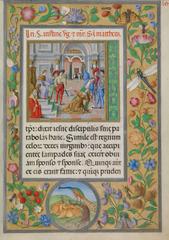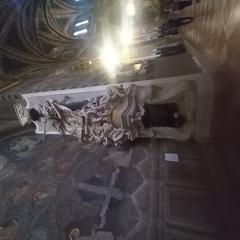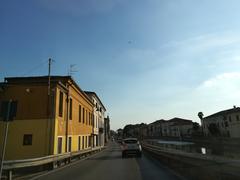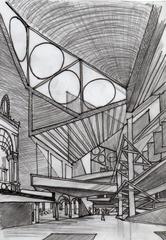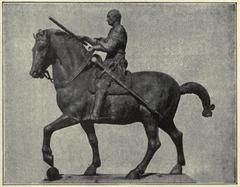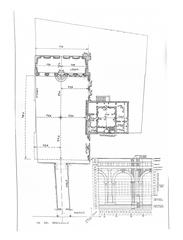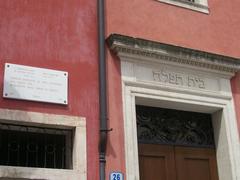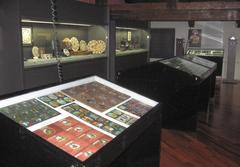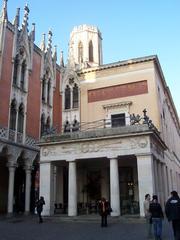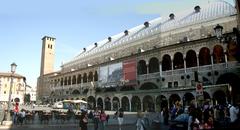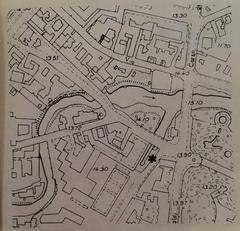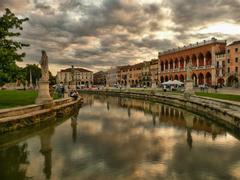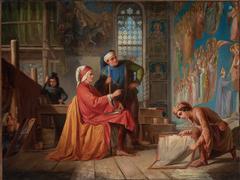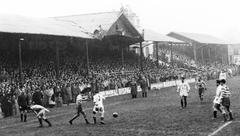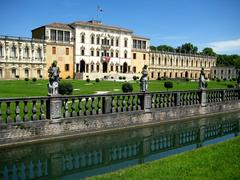
Torre dell’Orologio Visiting Hours, Tickets, and Guide to Padua’s Historical Sites
Date: 04/07/2025
Introduction: The Torre dell’Orologio and Its Significance in Padua
In the heart of Padua’s historic center, the Torre dell’Orologio stands as a striking symbol of the city’s medieval and Renaissance achievements, scientific innovation, and civic pride. Located in the bustling Piazza dei Signori, this architectural masterpiece uniquely blends Gothic and Renaissance styles, while its astronomical clock has marked time for centuries. Originally constructed in the 14th century under the Carrarese family and later reconstructed by the Republic of Venice, the tower houses one of Europe’s oldest functioning astronomical clocks, displaying not just the time but also lunar phases and the sun’s path through the zodiac, based on the geocentric model. The Torre dell’Orologio reflects the Renaissance synthesis of art, science, and civic authority, making it a testament to Padua’s historic role as a center of learning, innovation, and culture (Padova Musei, Renato Prosciutto, The Travel Folk, Italy Notes).
Table of Contents
- Introduction
- History: Medieval Origins, Venetian Reconstruction, and Renaissance Enhancements
- The Astronomical Clock: Features, Legends, and Scientific Importance
- Architecture and Symbolism
- Civic, Religious, and Community Functions
- Integration with Padua’s Heritage
- Visiting the Torre dell’Orologio: Practical Information
- Visitor Experience and Etiquette
- FAQ
- Conclusion and Further Resources
History: Medieval Origins, Venetian Reconstruction, and Renaissance Enhancements
Medieval Foundations and the Carrarese Era
The origins of the Torre dell’Orologio date to the prosperous mid-14th century under the Carrarese family, who ruled Padua as Lords. The tower was initially conceived as a fortified entrance to the Carrarese Royal Palace, strategically positioned between the Palazzo dei Camerlenghi and the Palazzo del Capitanio in what is now Piazza dei Signori (Piazza dei Signori). In 1344, engineer and astronomer Jacopo Dondi of Chioggia was commissioned to design an astronomical clock capable of displaying the hours, months, lunar phases, and the sun’s movement through the zodiac—an extraordinary achievement for its time (Padova Musei, Atlas Obscura).
Destruction and Venetian Reconstruction
The original tower and clock were destroyed in the conflicts with the Visconti in the late 14th century. After Padua’s conquest by Venice in 1405, the Venetians rebuilt the tower atop the ruins of the Carrarese palace’s eastern gate. By 1423, the reconstructed tower reached 30 meters and soon hosted a new astronomical clock, crafted by Matteo Novello and the Dalle Caldiere brothers, which closely followed Dondi’s original design but famously omitted the zodiac sign Libra (Italyscapes, Atlas Obscura).
Renaissance Enhancements and Symbolism
In 1532, architect Giovanni Maria Falconetto redesigned the base of the tower as a triumphal arch, adorned with four columns and the Lion of Saint Mark—symbol of Venetian rule. Statues and heraldic emblems further asserted Venice’s authority, while Falconetto’s renovations introduced Renaissance proportions and decorative motifs (Wikipedia, Padova Musei, Italyscapes).
The Astronomical Clock: Features, Legends, and Scientific Importance
Clock Design and Mechanism
The Torre dell’Orologio’s clock is a marvel of medieval engineering. Its dial features concentric rings: Roman numerals for the hours, copper stars, and zodiac reliefs at the center. The original 1344 mechanism was lost, but the 15th-century reconstruction by Novello Dondi and the Dalle Caldiere brothers restored its complex functions (Renato Prosciutto). Key features include:
- 24-hour dial: The hour hand makes a full revolution every 24 hours.
- Astronomical indications: Lunar phases, sun’s position in the zodiac, and day/month displays, all based on the geocentric model (Nomads Travel Guide).
- Zodiac signs: Notably, Libra is missing—a detail that has inspired legends about Dondi’s protest or references to ancient zodiac traditions (Padova Musei).
Mechanical Evolution and Restoration
Over the centuries, the clock has undergone multiple restorations, including the addition of pendulums, a bronze bell, and external devices for displaying hours and months. Its mechanism remains a rare example of functioning medieval astronomical engineering, maintained by local volunteers (Nomads Travel Guide, Renato Prosciutto).
Scientific and Educational Legacy
The Torre dell’Orologio was among the first public astronomical clocks in Europe, bridging the gap between science and civic life. Its display of celestial movements made astronomy accessible to the public, while its design and mechanism influenced future horological advances (Rossi Writes). Today, guided tours highlight its scientific and educational value, attracting enthusiasts and scholars alike.
Architecture and Symbolism
The Torre dell’Orologio embodies the confluence of Venetian Gothic and Renaissance styles, evident in its arches, battlements, and decorative art. Falconetto’s triumphal arch and Giorgio da Treviso’s gilded façade demonstrate Padua’s evolving architectural tastes and high craftsmanship (Renato Prosciutto, Nomads Travel Guide). The tower’s central location in Piazza dei Signori underscores its role in public life and civic identity.
Civic, Religious, and Community Functions
Historically, the clock tower regulated the rhythms of city life, marking hours for merchants, officials, and citizens. Its chimes and astrological motifs reflected the belief in celestial influences on human affairs. The tower’s proximity to key civic buildings made it a focal point for announcements, processions, and festivities, reinforcing the authority of Padua’s rulers and fostering community spirit (The Travel Folk).
Integration with Padua’s Heritage
The Torre dell’Orologio is part of Padua’s UNESCO World Heritage ensemble, complementing nearby sites such as the Scrovegni Chapel, Palazzo della Ragione, and the Botanical Garden. Its preservation is integral to maintaining the city’s historic landscape and cultural authenticity (The Travel Folk).
Visiting the Torre dell’Orologio: Practical Information
Tickets, Tours, and Accessibility
- Access: Entry is exclusively via guided tours to protect the monument. Tours are available in Italian, English, and French, lasting about one hour (visitmuve.it).
- Tickets: Full price €14; reduced €11 (children 6–14, students, over 65, Venetian residents, and others with valid ID). Children under 6 not permitted. Tickets include entry to nearby museums (visitmuve.it).
- Booking: Advance booking is essential due to limited group sizes.
- Tour Schedule (as of June 2024; verify on visitmuve.it):
- Italian: Mon, Fri, Sat, Sun 12:00; Thu–Sun 15:00
- English: Multiple slots Mon–Sun
- French: Tue, Wed 15:00; Thu 14:00; Sat 11:00; Sun 14:00
- Check-In: Arrive five minutes early at the Correr Museum ticket office.
- Accessibility: The tower’s narrow stairways and lack of elevators make it inaccessible for those with mobility impairments. Comfortable shoes and moderate fitness are recommended (bolognawelcome.com).
Amenities and Travel Tips
- Location: Piazza dei Signori, Padua, Italy; a 15-minute walk from the train station.
- Nearby: Cafés, restaurants, shops, and historic sites including Palazzo della Ragione and Basilica di Sant’Antonio.
- Best Time to Visit: Spring and autumn offer pleasant conditions and fewer crowds. Early morning or late afternoon visits are ideal for photography.
- Getting There: Use public transport or city buses; parking is limited.
Visitor Experience and Etiquette
- Photography: Allowed without flash or tripods.
- Group Size: Tours are small to ensure preservation and quality.
- Safety: Follow guide instructions; refrain from touching mechanisms or leaning on railings.
- Accessibility: The tower interior is not suitable for young children or those with mobility issues; the exterior can be appreciated from the piazza.
Frequently Asked Questions (FAQ)
Q: Can I visit the Torre dell’Orologio without a guided tour?
A: No, access to the interior is only possible via guided tours.
Q: Are tickets refundable?
A: Refer to the official website for policies; typically, tickets are non-refundable.
Q: Is the tour suitable for children?
A: Children under 6 are not permitted; older children are welcome.
Q: Is there parking nearby?
A: Limited parking is available; public transport is recommended.
Q: Are there other attractions nearby?
A: Yes, including Palazzo della Ragione, Basilica di Sant’Antonio, and the Botanical Garden.
Visual and Interactive Resources
- Images & Virtual Tours: Explore high-quality images and virtual tours on the official Torre dell’Orologio website. Use optimized alt tags such as “Torre dell’Orologio Padua astronomical clock” for accessibility.
- Maps: Embedded maps of Piazza dei Signori are available online for orientation.
Conclusion: Experience Padua’s Timeless Treasure
The Torre dell’Orologio stands as a living testament to Padua’s rich heritage, scientific curiosity, and artistic mastery. Its astronomical clock continues to fascinate visitors with its blend of mechanical ingenuity and Renaissance artistry. Plan your visit by booking a guided tour, exploring related museums, and taking in the vibrant atmosphere of Piazza dei Signori. For a seamless experience, download the Audiala app for updates, ticketing, and expert guides to Padua’s heritage.
References and Further Reading:


